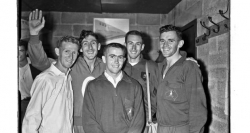Sixty years on from the night five men made Mile history in Santry

It was simply the most significant race ever run in Ireland, despite the intrusion of a black and white mongrel dog midway through the race, and it lived up to its billing to the letter.
By Peter Byrne for The Irish Times
In an extract from his forthcoming book Winning for Ireland, Peter Byrne recalls a brilliant night in Santry 60 years ago on Wednesday, August 6 when five men, including Irish running legend Ronnie Delany, broke the "magic" 4 minute Mile barrier.
Billy Morton had a way with words. Enthusiastic and effusive in full spate, he could still capture the attention of his audience like few others on those occasions when he needed to be quick and straight to the point after we, in the sporting press, were required to attend briefings at the back of his optician’s shop on Berkeley road on Dublin’s north side.
And so it was, that we made our way in the general direction of the Mater Hospital – he always used that landmark in much the same way as the traffic control office might guide the emergency services to a specific location – after being summoned in the cause of duty in the spring of 1958.
“Gentleman,” he began, “grass is on the way out” before going on to wax lyrical on the modern shale track being planned for the pristine stadium he was building as the new home of Clonliffe Harriers in particular and Irish athletics in general.
Ever since Croke Park closed its gates to athletics for the last time after the NACA championships in 1933 – the 100 yards championship staged there six years later, being a one-off concession – the sport had no suitable stadium in Dublin.
True, Lansdowne Road and College Park had been used on occasions for the big invitational meetings held under the auspices of the AAU, which by now couldn’t wait to shed the Eire part of its appellation, but in each instance, athletes had to make do with running on grass. That was, at best, an embarrassing anachronism at a time when the western world generally, was moving towards artificial surfaces and it encouraged Morton to tilt against financial logic and literally risk house and home, by committing himself to the construction of Santry Stadium, later renamed in his honor.
After several false starts, Irish athletics was at last to have a purpose built arena in north Dublin and as befitted a man who was invariably thinking outside the box, Billy Morton was already laying his plans for the lavish international meeting which would introduce his stadium to the world.
The British Empire Games were due to be staged at Cardiff in July 1958 and it was the intention of the maestro to piggy back on that promotion, to boost the appeal of a two-day meeting in the first week of August.
Runners like Murray Halberg of New Zealand had never previously set foot in Ireland but his media profile was such that people here were able to identify readily with a man who overcame a physical disability to become one of the best middle distance runners in the world. And yet, undeniably, it was the exceptionally talented Australian squad of the time, which gave real gravitas to the Santry program.
John Landy was now in retirement but the legacy of the great man was such that his record of achievement would inspire a whole new generation of gifted middle distance runners down under. Men like Merv Lincoln and Albie Thomas were unbeatable in the mood but the ace in the pack was a young athlete from Melbourne who was already being hailed as an even more prodigious talent that Landy.
Greatest Miler
Herb Elliott was just 20 at the time, a slim, unassuming man who had only recently graduated from St. Aquinas CBC where it was said, his athletic prowess was excelled only by his academic ability.
Now he was channelling all his endeavors into sport and the end package, as illustrated in Cardiff where he completed the 800 and 1500 meter double, was quite magnificent. If any runner was capable of beating Ronnie Delany in his home town, the experts reasoned, it was the youngest and potentially, the greatest Miler in the Southern Hemisphere.
Continue reading at: irishtimes.com
Mile world record progression HERE.
